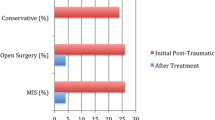Summary
The findings of this study emphasize the importance of distraction in obtaining and maintaining reduction in upper thoracic fractures that are unstable and collapsing into kyphosis. It also shows that a Luque rectangle construct cannot fulfill this function adequately in this type of fracture. Thirty-four consecutive cases of surgically treated upper thoracic spine fractures were reviewed. Two patients died, and 4 were lost to follow-up, so after a minimum 6-month clinical and radiographic follow-up there were 11 patients in the Luque group and 17 in the distraction rod group. Preoperatively, there was no significant difference in age, sex, level of injury or severity of kyphosis between the two groups. The Luque stabilization took an average of 1 h longer. There was no difference in local, general or neurological complications between the groups. Pain at the final follow-up was the same according to analgesic use. The kyphosis in the Luque group increased progressively from preoperative to postoperative values continued and to increase. In the distraction rod group the postoperative kyphosis was improved compared with the preoperative values. At final follow-up the kyphosis had returned nearly to the preoperative values. The difference in the adequacy of the reduction as measured by percentage of anterior collapse between the two groups is highly statistically significant: distraction rod better post-operatively,P = 0.0114 (Student'st-test); distraction rod better at final follow-up,P = 0.0054 (Student'st-test).
Similar content being viewed by others
References
Aebi M, Etter C, Kehl T, Thalgott J (1987) Stabilization of the lower thoracic and lumbar spine with internal spinal skeletal fixation system: indications, techniques, and the first results of treatment. Spine 12:544–551
Argenson C, Lovet J, De Peretti F, Perraud M, Boileau P, Cambas P, Griffet J (1991) Ostéosynthèse des fractures vertébrales thoracique et lombaires par matériel Cotrel-Dubousset (110 cas). Acta Orthop Belg. 57:165–175
Baker SP, O'Neill B, Haddon W, Long WB (1974) The injury severity score: a method for describing patients with multiple injuries and evaluating emergency care. J Trauma 14:187–196
Blamoutier A, Milaire M, Garreau de Loubresse C, Lassale B, Deburge A (1992) L'instrumentation de Cotrel-Dubousset dans le traitement des fractures de la charnière dorso-lombaire et du rachis lombaire. Rev Chir Orthop 78:529–535
Bohlman HH (1985) Treatment of fractures and dislocations of the thoracic and lumbar spine. J Bone Joint Surg [Am] 67:165–169
Bryant CE, Sullivan JA (1983) Management of thoracic and lumbar spine fractures with Harrington distraction rods supplemented with segmental wiring. Spine 8:532–537
Cobb JR (1948) Outline for the study of scoliosis. (Instructional Course Lectures 5) The American Academy of Orthopaedic Surgeons, Ann Arbor, pp 261–275
Daniaux H, Seykora P, Genelin A, Lana T, Kathrein A (1991) Application of posterior plating and modifications in thoracolumbar spine injuries: indications, techniques, and results. Spine 16:S125-S133
Denis F (1983) The three column spine and its significance in the classification of acute thoracolumar spinal injuries. Spine 8:817–831
Denis F, Armstrong GWD, Searls BA, Matta L (1984) Acute thoracolumbar burst fractures in the absence of neurologic deficit. Clin Orthop 189:142–149
Denis F, Ruiz H, Searls K (1984) Comparison between squareended distraction rods and standard round-ended distraction rods in the treatment of thoracolumbar spinal injuries. Clin Orthop 189:162–167
Dick W, Kluger P, Magerl F, Woesdorfer O, Zach G (1985) A new device for internal fixation of thoracolumbar and lumbar spine fractures, the 'fixateur interne'. Paraplegia 23:225–232
Drummond DS, Keene JS (1988) Spinous process segmental spinal instrumentation. Orthopaedics 11:1403–1410
Esses SI (1989) The AO spinal internal fixator. Spine 14:373–378
Frankel HL, Hancock DO, Hyslop G, Melzac LS, Ungar GH, Vernon JDS, Walsh JJ (1969) The value of postural reduction in the initial management of closed injuries of the spine with paraplegia and tetraplegia. Part I. Paraplegia 7:179–192
Gertzbein SD, MacMicheal D, Tile M (1982) Harrington instrumentation as a method of fixation in fractures of the spine. J Bone Joint Surg [Br] 64:526–529
Gertzbein SD, Jacobs RR, Stoll J, Martin C, Marks P, Fazl M, Rowed D, Schwartz M (1990) Results of a locking-hook spinal rod for fractures of the thoracic and lumbar spine. Spine 15:275–280
Gurr KR, McAfee PC, Shih CM (1988) Biomechanical analysis of anterior and posterior instrumentation systems after corporectomy: a calf spine model. J Bone Joint Surg [Am] 70:1182–1191
Jacobs RR, Asher MA, Snider RK (1980) Thoracolumbar spine injuries: a comparative study of recumbent and operative treatment in 100 patients. Spine 5:463–477
Kostuik JP (1984) Anterior fixation for fractures of the thoracic and lumbar spine with our without neurologic involvement. Clin Orthop 189:103–115
Luque ER, Cassis N, Ramirez-Wiella G (1982) Segmental spinal instrumentation in the treatment of fractures of the thoracolumbar spine. Spine 7:312–317
McAfee PC, Bohlman HH (1985) Complications following Harrington instrumentation for fractures of the thoracolumbar spine. J Bone Joint Surg [Am] 67:672–686
McAfee PC, Bohlman HH, Yuan HA (1985) Anterior decompression of traumatic thoracolumbar fractures with incomplete neurological deficit using a retroperitoneal approach. J Bone Joint Surg [Am] 67:89–104
McAfee PC, Werner FW, Glisson RR (1985) A biomechanical analysis of spinal instrumentation systems in thoracolumbar fractures: comparison of traditional Harington distraction instrumentation with segmental spinal instrumentation. Spine 10:204–217
McLain RF, Sparling E, Benson DR (1993) Early failure of short segment pedicle instrumentation of thoracolumbar fractures. J Bone Joint Surg [Am] 75:162–167
Noel SH, Keene JS, Rice WL (1991) Improved postoperative course after spinous process segmental instrumentation of thoracolumbar fractures. Spine 16:132–136
Roy-Camille R (1986) Internal fixation of the thoracolumbar spine with pedicle screw plating. Clin Orthop 203:7–17
Sasso RC, Cotler HB, Rueben JD (1991) Posterior fixation of thoracic and lumbar spine fractures using DC plates and pedicle screws. Spine 16(3S):S134-S139
Willén J, Lindahl S, Nordwall A (1985) Unstable thoracolumbar fractures: a comparative clinical study of conservative treatment and Harrington instrumentation. Spine 10:111–122
Author information
Authors and Affiliations
Rights and permissions
About this article
Cite this article
Huckell, C.B., Powell, J., Eggli, S. et al. A comparative analysis of distraction rods versus Luque rods in thoracic spine fractures. Eur Spine J 3, 270–275 (1994). https://doi.org/10.1007/BF02226578
Issue Date:
DOI: https://doi.org/10.1007/BF02226578




